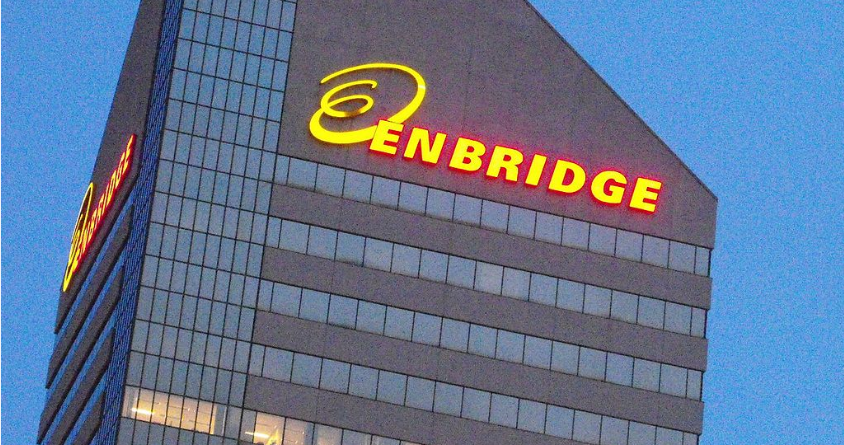
State officials reveal Line 5 permit application at risk
On Friday, October 27th, Enbridge admitted the company knew a section of protective coating on Line 5 in the Straits of Mackinac was damaged as early as 2014, but didn’t tell state officials about it until August, 2017.
This new information created an outcry, with critics of Line 5 saying not only is the safety of the pipeline that carries 23 million gallons of oil per day at risk, so is the trust between the state and Enbridge.
Enbridge spokesperson Ryan Duffy tells Great Lakes Now, “The safety of the pipeline was never compromised; this was an internal reporting issue.”

Michigan Attorney General Bill Schuette, courtesy of michigan.gov
Attorney General Bill Schuette’s response: “Trust and transparency are critical in any relationship. This latest revelation by Enbridge means the faith and trust Michigan has placed in Enbridge has reached an even lower level. Enbridge has to do more than apologize, Enbridge owes the citizens of Michigan a full and complete explanation of why they failed to truthfully report the status of the pipeline.”
The damage to the coating occurred when Enbridge was installing anchors which were supposed to do a better job of securing the pipeline to the lake bottom near the Mackinac Bridge.
Inspection reports Enbridge shared with the state in September show eight areas on the pipeline where bare metal is exposed to the elements. Some of the spots where the protective coating wore off are larger than a foot in diameter.
The protective coating is required on the pipeline as part of the 1953 easement.
The Michigan Department of Environmental Quality is considering an Enbridge permit to install more than 22 additional anchor supports.
Just this past March, Enbridge told the state’s Pipeline Safety Advisory Board there were no known concerns about the Line 5 coating – despite the fact they had documentation of the damage in 2014.
The Michigan Department of Environmental Quality, Michigan Agency for Energy (MAE) and Michigan Department of Natural Resources issued joint statements expressing concerns that Enbridge knew about the damage in 2014 and failed to disclose it to state agencies.
DEQ director Heidi Grether said, “The DEQ is going to take this revelation very seriously and will conduct a thorough assessment of the information to consider during our continued review of the permit application.”
“The Trust we had in Enbridge has been seriously eroded”
Valerie Brader, Executive Director of MAE and co-chair of the Pipeline Safety Advisory Board says, “We are deeply disappointed that Enbridge did not tell the Pipeline Safety Advisory Board in March the whole story about Line 5 coating deficiencies. Enbridge owes the people of Michigan, the Advisory Board and the State an apology.”

Valerie Brader Executive Director of the Michigan Agency for Energy, courtesy of michigan.gov
Brader says, “This issue is too important to the people of Michigan to not tell the truth in a timely manner and right now any trust we had in Enbridge has been seriously eroded.”
DNR director Keith Creagh says, “The recent finding and reporting by Enbridge clearly demonstrates the need for greater transparency and oversight where Line 5 is concerned. We will be seeking to ensure there are mechanisms in place to increase communications and stewardships on the part of Enbridge in the future.”
Deputy State Director of Emergency Management and Homeland Security and commander of the Michigan State Police Emergency Management and Homeland Security Division Captain Chris Kelenske says, “I am concerned by Enbridge’s lack of transparency when it comes to Line 5. It is imperative to have a good working relationship with our public and private sector partners to ensure public safety. When one of our partners withholds vital information, it makes emergency and disaster preparedness, response, and recovery difficult.”
Mike Shriberg, Executive Director of the National Wildlife Federation’s Great Lakes Regional Center and a member of the Michigan Pipeline Safety Advisory Council goes a step further.

Mike Shriberg, Great Lakes regional executive director of the National Wildlife Federation, courtesy of nwf.org
Shriberg tells Great Lakes Now: “The fact that Enbridge has known about these breaks in coating for years is, unfortunately, less surprising than it ought to be. It seems every month there is a new revelation about the deteriorating condition of Line 5 and Enbridge’s lack of transparency. This is the wrong pipeline in the wrong location operated by the wrong company. We cannot continue to allow this pipeline to jeopardize our Great Lakes.”
A risk analysis on line 5 conducted by a team of academic scientists is scheduled to be finished by June.
The 645-mile long pipeline built in 1953 runs from Superior, Wisconsin to Sarnia, Ontario.
“We regret that this miscommunication may have caused confusion for state officials and the public”
Enbridge spokesman Ryan Duffy issued the following statement to DPTV’s greatlakesnow.org:
“Enbridge continues to provide information to the State of Michigan in response to information requests as the State is processing a permit application for ongoing maintenance work on Line 5 in the Straits of Mackinac. Recently, we informed the State that installation of a pipeline support anchor in 2014 resulted in some coating damage that did not harm the pipe itself. The coating was repaired this year during a scheduled underwater inspection of the line. We want to emphasize that the safety of the pipeline was never compromised.”“Engineers in Enbridge’s pipeline integrity department have been aware of the coating damage since they occurred in 2014. Our pipeline integrity department continued to monitor these areas, and the coating damage was determined not to present any threat to the safety of the pipeline at any time. “
“Earlier this year, Enbridge representatives said they were not aware of any sections of bare metal along Line 5 in the Straits. At the time, these statements were accurate to the best of their awareness. However, information from our integrity department has surfaced as a result of the State’s information request, and we are sharing this information publicly. Again, the safety of the pipeline was never compromised; this was an internal reporting issue.”
“As our dialogue with the state continues, Enbridge has come to recognize that issues which do not present a threat to the safety of the pipeline can still present a strong concern to Michigan, and we are adjusting our communication approach accordingly.”
“We regret that this miscommunication may have caused confusion for state officials and the public. We are committed to being transparent on all matters related to the safe operations of our pipelines in Michigan.”
DPTV’s Great Lakes Bureau greatlakesnow.org will continue to bring you the latest developments on this story.
1 Comment
-
I agree with Mr. Shriberg that the Great Lakes are more precious than the oil pipe. And, much like we are finding our aging water pipes all over the country, nothing lasts forever. So, it should not be too early to be planning for a new pipe line, a pipe line with state of the art safety features. Cost must be secondary to safety. I’m thinking, multiple shut-off valves to isolate trouble areas, much like the compartments of a ship to stop water intake to a damaged hull. And, the ability to drain oil out of the pipe in an emergency. For the current aging pipe, we should at least have the ability to draw oil out of the pipe should a leak occur.




